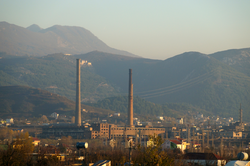Difference between revisions of "Istore"
Pittman789 (talk | contribs) (Created page with "{{Infobox settlement | name = Istore | native_name = <small>Vichavian:</small> ''Istolo''<br><small>Richavian:</small> ''Istoriv''<br><small>Maravian:</small> ''Istolev''<br><small>Najavian:</small> ''Yestorev''<br><small>Azavian:</small> ''Yestorastovo''<br><small>Vadmivian:</small> ''Yestlita'' | native_name_lang = <!-- ISO 639-2 code e.g. "fr" for French. If more than one, use {{lang}} instead --> | settlement_type = <!--...") |
Pittman789 (talk | contribs) |
||
| Line 30: | Line 30: | ||
| subdivision_type = Country | | subdivision_type = Country | ||
| subdivision_name = {{flag|Vanosha}} | | subdivision_name = {{flag|Vanosha}} | ||
| subdivision_type1 = {{flagicon|Vanosha}}[[Vanoshan Union]] | | subdivision_type1 = {{flagicon|Vanosha}} [[Vanoshan Union]] | ||
| subdivision_name1 = Istore Province | | subdivision_name1 = Istore Province | ||
| subdivision_type2 = | | subdivision_type2 = | ||
Revision as of 11:58, 17 July 2022
Istore
Vichavian: Istolo Richavian: Istoriv Maravian: Istolev Najavian: Yestorev Azavian: Yestorastovo Vadmivian: Yestlita | |
|---|---|
 View of Istore | |
| Etymology: Flower of desire | |
| Country | |
| Istore Province | |
| Organized | 1354 |
| Elevation | 1,412 m (4,633 ft) |
| Population | |
| • Total | 858,215 |
| Demonym(s) | Istorian |
Istore (Vanoshan: Istolo /ˈistolo/) is a ...
Etymology
The city was named "Flower(s) of desire", referring to the various mountain meadows that surround the area, creating a multi-colored effect throughout spring and summer.
History
The area was formally organized sometime in the 11th century, where Zarasaist clerics established a monastery named Ajane. The monastery was noted for its fortress like design meant to deter the Vanoshan raiders from the north. A small settlement began to form around the monastery until in the 14th century, it was consolidated within the formal boundaries of the monastery and a free city developed with a population of roughly 16,000. The settlement grew prominently and eventually became the seat of the Duchy of Vanosha within the Khezi kingdom to the south. Following the 17th century revolt, the duchy joined the neighboring Vichavian dukedom as and together formed the Kingdom of Vanosha.
Ajane was formally renamed in 1801 as one of its residential areas, Istulev, grew larger and wealthier than the rest of the settlement, following a century of increased migration from the rest of the Vanoshan kingdom. Around the same time, Istulev was made the official sole capital of the kingdom. With much of the economic activity of the country funneling into the city, it became the wealthiest settlement in the entire nation throughout the 19th century, seeing a rail line connecting the city with Khezan and later Lenezan during the mid to later half of the century. The first factories in Vanosha were established in Istulev, resulting in the city being nicknamed the "burning rose" by contemporaries at the time. Its diverse communities, being a frequent stop between Lenezan and Khezan direct lines, and its wealth led to levels of activity that was unheard of in the rest of the nation.
The city was later the center of events in the nation, being the locale where the Officers' coup took place, and later became the capital of the new Union of Vanosha. Throughout the 30s it was noted for the construction of the Śéśvonep, an engineering and research complex, built under the supervision by Chief of the VAI, Svuso Vyerečev. The complex transformed much of the industry as college level education was now available for factory workers in the capital of the nation, whereas before education was limited on a generic basis. Since the 30s, much of the city has transformed to accomodate this complex which has since replaced much of the original monastery grounds, with the old Ajane monastery's relics and artifacts being relocated to a vault in the hills that overlook the city. In 1942, the city was renamed to Istore to match the colloquial pronunciation rather than the historical pronunciation, along with several other cities.
Today, the city enjoys a much significantly higher quality of life from the rest of the country. It is a common tourist attraction as the NAM government attempts to contain tourism to a select few centers. This in turn has led to a restaurant and cafe culture unique to the city despite the near-totalitarian governance of the country, in part due to its favored status as the outward image it desires to share with the world.